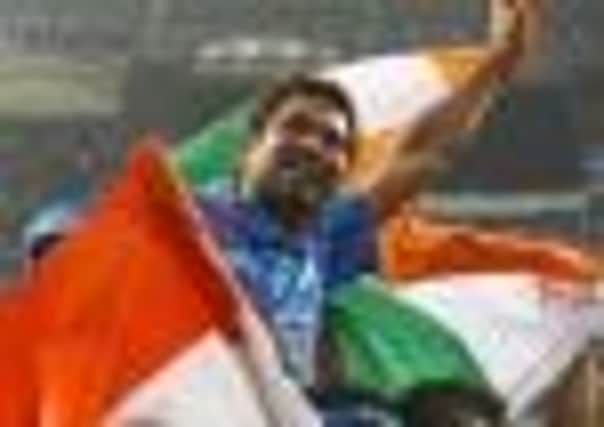Sachin Tendulkar, India’s cricketing god, bows out at the top


In the 1990s, if you were an Indian cricket fan worth your salt and Sachin Tendulkar had just been given out in a one-day international, the unwritten rule was simple: “Switch the TV off”.
For a nation that back then had only recently opened up its financial borders to the world, cricket was the fulcrum that either boosted or lowered the sensex ratings on the Bombay Stock Exchange.
Advertisement
Hide AdAdvertisement
Hide AdThe glamour of One Day Internationals pulled in audiences and Tendulkar ensured they would never leave.
His retirement from 50-over cricket is the end of an era but, in addition, a part of India has receded into the background. Things will never be the same again for a billion cricket fans.
Tendulkar was the face of cricket for India – many would argue he still is. In his heyday, his presence guaranteed a full house. No mere feat considering the “Little Master” was playing in the same ranks as Rahul Dravid, Saurav Ganguly and VVS Laxman. He was WG Grace, and Don Bradman combined for India – you came to watch him, the cricket itself was incidental.
Winning the 1983 World Cup had transformed ODI cricket from something India were relatively good at to a national passion where defeat was unthinkable and victory an expectation. And once again, Tendulkar’s presence all but made that outcome certain in our minds.
Tendulkar credits watching the 1983 victory on television as an inspiration. When held aloft by his team-mates on a lap of honour at the Wankhede in April 2011, only he knows how much of that early memory crossed his mind.
His popularity made him a godsend for advertisers, and there is perhaps no city in India without a huge billboard where he endorses some product. But Tendulkar off field was much more than advertising space.
He was the face of an emerging nation who saw their hopes and dreams reflected in this little man from Mumbai. His distinctive action of adjusting the “box” was imitated in neighbourhood parks across India.
Street cricket was never devoid of that one child who had apparently hit it “exactly like Sachin”. As Tendulkar-mania swept the country, the number of cricket-crazy fathers who christened their sons “Sachin” was on the rise. But this was more than the fleeting superstardom seen today –Tendulkar’s was a brand of solid popularity destined for a long innings.
Advertisement
Hide AdAdvertisement
Hide AdIf Tendulkar was great and India won, businesses thrived and people were happy. Heaven help if the opposite happened, as in 1996, when playing Sri Lanka in the World Cup semi-final in Kolkata’s Eden Gardens.
Chasing 252, Tendulkar was in fine form with 65, but his dismissal sparked a mini-collapse and with the match quickly slipping away, the Indian spectators threw bottles and set fires.
The umpires handed the match to Sri Lanka by default. The sight of India’s Vinod Kambli walking off field in tears is one that still brings a shudder.
But overall, it has been a journey of joy for him, and destroying the Aussie bowlers in a series in UAE prior to the 1999 World cup is this author’s favourite.
Charging down the track to pacemen such as Jason Gillespie and Michael Kasprowicz and hitting them for six, making Shane Warne feel helpless, and almost single-handedly leading India to the title – he summed up why India uses the phrase: “Cricket is a religion and Sachin is God”.
In 1999, on World Cup duty in England, Tendulkar’s father died. He flew home for the funeral, but returned just days later to score a century against Kenya.
Anyone else may not even have left the house, let alone carry the hopes of a nation. His brother Nitin said the knock was “unbelievable”, not for the manner of scoring but for Sachin’s “frame of mind”. And it summed up why Tendulkar has carried on so far – hunger and passion.
Recently, his form has dipped, but in two sublime innings the man with almost every record imaginable proved yet again why the title “Little Master” was rightfully handed to him from Sunil Gavaskar. Being the first to score a double century in ODIs – against South Africa – was only trumped by reaching his 100th career century, fittingly, in a 50-over game against Bangladesh.
Advertisement
Hide AdAdvertisement
Hide AdIn a felicitation ceremony after that 100th 100, attended by the elite of both Indian cricket and Bollywood, Tendulkar was asked if his record could be broken. The response was simply: “One of the youngsters in this room perhaps. As long as it’s an Indian, I don’t mind.”
We may never have another Sachin, but as he retired from one-day cricket so India may prepare for the 2015 World Cup, one hopes there is a fresh face who has found inspiration similar to that which drove the great man to inspire a generation.
BATTING
Matches463
Innings452
Runs scored18,426
Highest innings score: 200 not out (versus South Africa, February 24 2010)
Average: 44.83
Balls faced: 21,367
Strike Rate: 86.23
Centuries: 49
Half-centuries: 96
Fours: 2,016
Sixes: 195
Not outs: 41
BOWLING AND FIELDING
Matches: 463
Innings: 270
Deliveries: 8,054
Runs conceded: 6,850
Wickets: 154
Best figures: 5 for 32 (versus Australia, April 1 1998)
Average: 44.48
Economy: 5.10
Strike Rate: 52.2
Four-wicket innings: 4
Five-wicket innings: 2
Catches taken: 114